Regeneration guidelines for sweet potato
|
View regeneration guidelines in full (in PDF)
Also available in the following languages: |
The information on this page was extracted from:
Rossel G., Espinoza C., Javier M. and Tay D. 2008. Regeneration guidelines: sweet potato.
In: Dulloo M.E., Thormann I., Jorge M.A. and Hanson J., editors. Crop specific regeneration guidelines [CD-ROM]. CGIAR System-wide Genetic Resource Programme, Rome, Italy. 9 pp.
Before reading the regeneration details for this crop, read the general introduction that gives general guidelines to follow by clicking here.
Introduction
Sweet potato (Ipomoea batatas (L.) Lam.) is a herbaceous, perennial plant belonging to the Convolvulaceae family. It has a vine system that expands rapidly and horizontally along the ground.
Although its growth habit is mainly prostrate, it varies from erect and semi-erect to spreading. Sweet potato is the world’s seventh most important food crop, after wheat, rice, maize, potato, barley and cassava. More than 133 million tonnes of sweet potato are produced globally per year, more than 95% in developing countries (www.cipotato.org). The most common names for this plant in Latin America are batata, camote, boniato, batata doce, apichu and kumara.
Sweet potato was probably domesticated more than 5000 years ago, in either South America or Central America, with recent evidence suggesting the latter (Rossel et al 2001). The CIP genebank contains 6855 accessions of Ipomoea batatas (4616 landraces and 2239 improved cultivars and breeding materials) and 1171 accessions of 67other Ipomoea species. The former are mainly conserved vegetatively in pots in greenhouses or screenhouses or under in vitro culture. Wild, related species and 2556 landrace accessions are conserved as seeds in cold chambers.
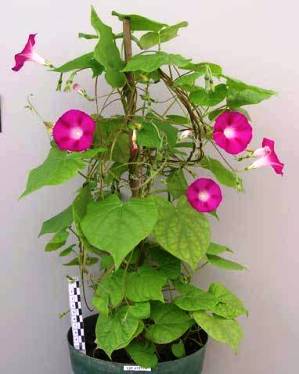
Wild sweet potato plant, Ipomoea purpurea (L.) Roth. |
Within a sweet potato collection, a wide variation is generally observed in the flowering habits of different accessions. Under normal sowing conditions, some cultivars do not flower. Several techniques have been developed to promote sweet potato flowering, including short photoperiod, grafting, trellises etc. This guide describes the procedures for regeneration of seed collections of Ipomoea batatas and other wild relatives.
A wide range of additional information about sweet potato can be found at the Sweetpotato Knowledge Portal.
Choice of environment and planting season
Climatic conditions
- Sweet potato grows at latitudes ranging from 40°N to 32°S. On the equator it is grown at altitudes from sea level to 3000 masl (Huaman 1987).
- It is a semi-tropical plant that grows best between 20 and 30°C and requires a minimum of 5 months of frost-free growing conditions with abundant sunshine (a photoperiod of 13–15 hours light is recommended) and warm nights. Colder temperatures injure the roots.
- Annual rainfall of 750–1000 mm is ideal, with a minimum of 500 mm in the growing season (Ahn 1993).
Planting season
- Sweet potato can be grown all year round if soils are well drained. In the coastal region of Peru it grows best when planted from September to November.
Preparation for regeneration
When to regenerate
- When seed germination falls below 85%.
-
When number of stored seeds is less than 2000.
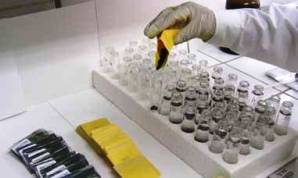
Sweet potato seeds submerged in concentrated sulphuric acid for scarification. (photo: Victor Fernandez/CIP)
- For evaluation trials.
- For preparing safety duplication of seed collection.
Seed scarification and germination
Seed germination is difficult and requires scarification by mechanical abrasion or chemical treatment.
- Before scarification, submerge seeds in three disinfectant solutions: first 1N hydrochloric acid (HCl), followed by a soapy solution and finally 96% ethanol for 5 minutes in each. Scarify the seed testa with a scalpel or sandpaper.
- Chemical treatment: place seeds in plastic mesh and submerge them in concentrated sulphuric acid (see photo) until the acid starts turning dark (10–40 minutes). Rinse in running water overnight.
- After scarification, place 30 seeds in Petri dishes with filter paper. Keep the plates moist with distilled water.
- Put plates in a germination chamber at 18–20°C, 80% humidity and photoperiod of 12 hours light.
- Evaluate every 7 days for 3 weeks.
- Register germination date for each accession.
- If mean germination is above 85% continue to store the accession; if not, schedule the accession for regeneration.

Sweet potato seedling transplanted into 20-cm pot. |
Preparation of planting material
- Sow seedlings into compressed peat (e.g. Jiffy-7) pots.
- After 30 days transplant into 20-cm pots (see photo) with soil composed of moss, dark-brown earth and sand (2:1:1).
- After about 40–65 days from initial sowing plants are ready for grafting.
Preparation of rootstocks
- The most efficient rootstock is Ipomoea nil cv. Kidachi Asagao.
- Germinate seeds on Petri dishes with filter paper. Keep plates moist with distil ed water.
- After 8–10 days transplant seedlings into 20-cm pots with soil composed of moss, dark-brown earth and sand (2:1:1).
- After about 40–65 days from initial sowing plants are ready to receive grafts.
Labelling
- Label the pots appropriately by placing, for example, waterproof self-adhesive barcode labels onto plastic plant pot sticks. Labels should contain the following information: accession number, collecting number, genus and species, planting date.
- Use appropriate labels (e.g. self-tie barcode labels) to identify accessions in the field.
Method of regeneration
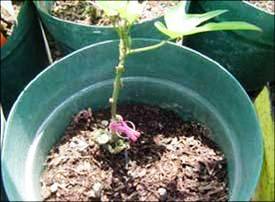 Sweet potato scion grafted onto rootstock from Ipomoea nil cv. Kidachi Asagao. (photo: Vilma Hualla/CIP) |
Planting layout, density and distance
- Plant 30 seeds per accession (one per pot) and place pots on tables in a greenhouse, keeping a space of 25 cm between pots.
Grafting onto rootstocks with profuse flowering
- Graft sweet potato scions onto rootstocks that produce large numbers of flowers simultaneously.
- Use a 'cleft' type of graft with a 15-cm sweet potato scion.
- Spray the grafted plants with a fungicide for a few minutes.
- Fix the graft with a small hook or parafilm (see photo) to seal the graft, cover the plant with a clear plastic bag and place it in shade for 1 week.
- After about 3 weeks, initiate a short-day treatment after pruning the tip of the scion.
- Best results are obtained when rootstock plants are young and the scions come from mature sweet potato plants.
Flowering induction
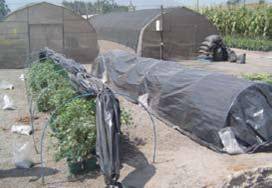 Use black plastic sheet to create short-day conditions to induce flowering. (photo: Vilma Hualla/CIP) |
Flowering and fruit set are highest at temperatures of 20–25°C and a relative humidity above 75%.
- Prepare a flowering bed made of frames to support black plastic or other dark material to cover plants.
- Transfer the grafted plants from the greenhouse to flowering beds.
- Cover the flowering beds at about 1600 h and remove covers the next day at about 0800h to stimulate flowering (see photo). Continue this short-day treatment for 1–2 months.
- Apply weekly sprays of 1000 ppm giberellic acid.
- Flower buds will appear about 3 weeks after short-day treatment.
- Once induced, move plants to a greenhouse for hand pollination or controlled pollination, or to an isolated field. In some cases, this short-day treatment must be repeated to assure continuous flowering.
- The use of trel ises makes flowering induction and seed production relatively efficient. The benefits are associated with the upward vegetative growth of plants, higher exposure to light, less attack from soil-borne pathogens and insects and by making it easier to col ect seed capsules. Structures such as tripods, stakes and wire mesh can be used as trel ises.
Pollination
Cross-pollination
- In the case of plants maintained in beds in the field, a day before flowers open, hold all petals with a clip or cover the flower buds with a glassine paper bag to avoid pollination or contamination with ‘foreign’ pollen.
- Remove the clips/paper bags when extracting anthers for pollination.
- Emasculate flower buds of female parents the afternoon before anthesis and cover them with glassine paper bags.
- Extract the pollen from anthers of the male parents and place it on the stigmas of female parents or rub the extracted anthers on the stigmas of female parents.
- Cover the pollinated flowers with a paper bag.
- Identify the flower with a label indicating: accession numbers of the parents, collecting number, genus and species, place and date of cross-pollination.
Open pollination
- Transfer the plants from the greenhouse to the field, near to beehives where bees and other insects will pollinate them.
Crop management
Evaluation of fertilization and seed formation
- Unfertilized flowers fall 2–3 days after pollination.
- Seed capsules form 30–50 days after pollination, depending on weather conditions.
Staking
- Provide appropriate stakes to support the spirals of the sweet potato vines and to avoid them mixing with other accessions.
Irrigation
- Immediately after transplanting, water the plants once a week. After 1 month, start watering twice a week.
Fertilization
- Apply fertilizers (N:P:K 15:15:15) monthly.
Common pests and diseases
- Damping-off caused by different soil-borne pathogenic fungi species, such as Pythium spp., Rhizoctonia and Fusarium, affects seedlings during transplantation.
- Whiteflies (Bemisia tabaci) are a major pest of sweet potato, transmitting viruses and other disease agents.
- Thrips can stunt and reduce growth in young transplants.
- Red spider mites (Tetranychus urticae) can infest plants in greenhouses. Heavily infested plants are severely weakened and may die.
- Contact plant health experts to identify the symptoms of the likely pests and diseases and the appropriate control measures.
Pest and disease control
- To control damping-off, apply a fungicide.
- To control thrips and whiteflies, apply monthly sprays of an insecticide.
- To control red spider mites, apply an acaricide/insecticide monthly.
Harvesting
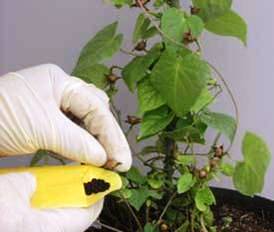
Harvesting sweet potato seed. |
The fruit of sweet potato is a capsule, more or less spherical with a terminal tip, and can be pubescent or glabrous. Each capsule contains one to four seeds that are slightly flattened on one side and convex on the other. Seeds are brown to black in colour and have a diameter of about 3 mm.
- Harvest periodically before capsules open to avoid seed losses, as not all plants produce seed at the same time (see photo).
- Keep harvested seeds in paper bags and identify them, preferably with barcode labels.
- Measure the 100-seed weight and total weight of seeds.
- Calculate the number of seeds (for a small number of seeds count manually).
- Record all data.
Post-harvest management
Seed cleaning
- Thresh by hand to remove all debris from seeds.
- Disinfect seeds with an appropriate disinfectant by keeping the treated seeds in Petri dishes sealed with parafilm and store for at least 30 days to detect if there is any insect emergence.
- If no insects are found, continue with normal packaging and storage procedures.
- Perform a germination test to calculate initial germination percentage.
Seed drying
Method 1 uses a silica gel desiccant under temperature-controlled conditions for 14 days to reduce seed moisture content to 7–10%.
- Weigh seed and silica gel at 1 g of seed: 2 g silica gel using a precision balance.
- Prepare the seeds and silica gel in separate Petri dishes to allow easy removal and renewal of the gel (when colour changes from deep blue to pink or pale blue).
- Place the Petri dishes on plastic trays and cover with plastic bags.
- Put the trays in an incubator set at 17°C.
- Distribute the trays evenly in the incubator.
Method 2 uses a drying chamber.
- Place seed bags in drying chamber (30°C) for 20 days until seed moisture reaches 7–10%.
- Package seed immediately to avoid rehydration.
Seed packaging
- Pack seeds into aluminium foil bags with about 1000 seeds per bag.
- Place waterproof self-adhesive barcode labels on the outside and inside of seed packets, with the following information: accession number, collecting number, type of seed (original, sib cross, open-pollination or self-pollination), year and place of collection or regeneration of seed, number of seeds, storage date, genus and species.
- Fill storage containers with the seed bags and seal immediately to protect the seeds from high ambient relative humidity.
- Store in storage room.
Seed storage
-
Two types of seed stores are used to conserve sweet potato germplasm:
- Medium-term storage (10 years) at 0°C (active collection): used for accessions with less than 60% germination or those that need to be regenerated.
- Long-term storage (50 years) at -20°C (base collection): used for accessions where germination is greater than 85%.
- In the storage facilities at CIP the aim is to store 1500–2000 seeds per accession for long-term conservation and 1500–2000 seeds per accession for an active collection.
Monitoring accession identity
- Verify accession identity using morphological descriptors according to the published list of sweet potato descriptors (CIP/AVRDC/IBPGR 1991).
- Take pictures.
- Prepare herbarium specimens.
Documentation of information during regeneration
Collect the following information during regeneration:
- Accession number
- Collecting number (Original number assigned by the collector(s) of the sample)
- Genus and species
- Country of col ection (Code of the country in which the sample was originally collected)
- Locality of regeneration
- Environmental conditions (altitude, temperature, precipitation)
- Field, plot, greenhouse, screenhouse reference
- Germination
- Number of plants established
- Days from sowing to flowering
- Method of pollination
- Number of pollinated flowers
- Pollination date
- Number of capsules obtained
- Date of capsule harvest
- Processing date
- Number of seeds obtained
References and further reading
Ahn PM. 1993. Tropical Soils and Fertilizer Use. Intermediate Tropical Agriculture Series.
Longman Scientific and Technical Ltd, UK.
Bioversity International, CIP. 2010. Key access and utilization descriptors for sweet potato genetic resources. Bioversity International, Rome, Italy; International Potato Centre (CIP), Lima, Peru. Available here.
CIP. 1999. Sweetpotato (Ipomoea batatas) Germplasm Management Training Manual. Huaman Z, editor. CIP, Lima, Peru.
CIP, AVRDC, IBPGR. 1991. Sweet Potato: Descriptors for Sweet potato. Huaman Z, editor. IBPGR, Rome, Italy.
Huaman Z. 1987. Current status on maintenance of sweetpotato genetic resources at CIP. In: Exploration, maintenance and utilization of sweetpotato genetic resources. Report of the First Sweetpotato Planning Conference 1987. CIP, Lima, Peru. pp. 101–120.
Rossel G, Kriegner A, Zhang DP. 2001. From Latin America to Oceania: The historic dispersal of sweet potato re-examined using AFLP. CIP Program Report 1999–2000. CIP, Lima, Peru. pp. 315–321.
Sweetpotato Knowledge Portal [online]. Available from: http://sweetpotatoknowledge.org/. Date accessed: 18 July 2011. The portal is supported by the International Potato Centre, CIP, and by the Sweetpotato Action for Security and Health in Africa (SASHA).
Acknowledgement
These guidelines have been peer reviewed by K. Abraham, Head of Crop Improvement Division, Central Tuber Crops Research Institute (CTCRI), India and Algerico Mariscal, Director, PhilRootcrops, Philippines.
Comments
- No comments found



 Sweet potato
Sweet potato

Leave your comments
Post comment as a guest